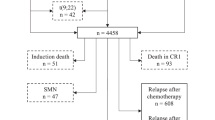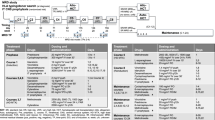Abstract
The Children’s Cancer Group (CCG) found that children with moderate risk acute lymphoblastic leukemia (ALL) had an improved 5-year event-free survival (EFS) rate when treated with therapy that included a doubled delayed intensification (DDI) vs a single DI (SDI) phase. Because of increased toxicity with DDI, it is important to determine whether subgroups of children with ALL can be identified who have excellent outcomes with SDI therapy. TEL-AML1 fusion and hyperdiploid DNA content are present in the leukemic blasts of significant proportions of children with ALL and have been associated with an excellent prognosis. In this study, we retrospectively examined the impact of TEL-AML1 status and ploidy on treatment outcome in a cohort of 75 children with standard risk ALL treated at our institution between 1983 and 1993 with SDI therapy. TEL-AML1 fusion was present in 19/43 (44%) evaluable cases. Fifteen of 56 (27%) evaluable cases were classified as hyperdiploid based on a modal chromosome number of ⩾51 and/or a DNA index of ⩾1.16. The 7-year EFS was 81% for the 19 TEL-AML1-positive patients vs 54% for the 24 TEL-AML1-negative patients (P = 0.0264). In multivariate analyses, TEL-AML1-positive status was associated with a superior EFS (P = 0.02) even when the intial white blood count was included in the model. Overall survival (OS) at 7 years for TEL-AML1-positive patients was 100% vs 83% for TEL-AML1-negative patients (P = 0.0677). There were no differences in 7-year EFS or OS based on ploidy comparisons. These results underscore the need to examine closely the effects of treatment intensification on specific biologically defined subgroups of children with ALL.
This is a preview of subscription content, access via your institution
Access options
Subscribe to this journal
Receive 12 print issues and online access
$259.00 per year
only $21.58 per issue
Buy this article
- Purchase on Springer Link
- Instant access to full article PDF
Prices may be subject to local taxes which are calculated during checkout
Similar content being viewed by others
Author information
Authors and Affiliations
Rights and permissions
About this article
Cite this article
Maloney, K., McGavran, L., Murphy, J. et al. TEL-AML1 fusion identifies a subset of children with standard risk acute lymphoblastic leukemia who have an excellent prognosis when treated with therapy that includes a single delayed intensification. Leukemia 13, 1708–1712 (1999). https://doi.org/10.1038/sj.leu.2401548
Received:
Accepted:
Published:
Issue Date:
DOI: https://doi.org/10.1038/sj.leu.2401548
Keywords
This article is cited by
-
Correlation of SRSF1 and PRMT1 expression with clinical status of pediatric acute lymphoblastic leukemia
Journal of Hematology & Oncology (2012)
-
Cloning and functional characterization of MEF2D/DAZAP1 and DAZAP1/MEF2D fusion proteins created by a variant t(1;19)(q23;p13.3) in acute lymphoblastic leukemia
Leukemia (2005)
-
Distinct patterns of hematopoietic stem cell involvement in acute lymphoblastic leukemia
Nature Medicine (2005)
-
Standardization and quality control studies of ‘real-time’ quantitative reverse transcriptase polymerase chain reaction of fusion gene transcripts for residual disease detection in leukemia – A Europe Against Cancer Program
Leukemia (2003)
-
Core-binding factors in haematopoiesis and leukaemia
Nature Reviews Cancer (2002)



